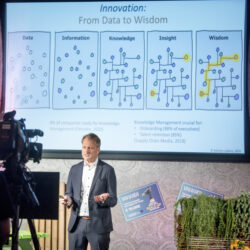Forecast-as-a-service supports rapid progress

There are various solutions available to supply chain professionals who are dissatisfied with their forecasting, such as to implement new software or set up their own data science team. A third option is to outsource their forecasting. In a webinar by Supply Chain Media, EyeOn explained the benefits of forecasting-as-a-service: “Outsourcing contributes to a carefree planning process.”
By Marcel te Lindert
Companies continue to struggle with demand planning and forecasting, even in today’s digital age. First and foremost, although the increasing degree of digitization means that they have more and more data at their disposal, this does not automatically lead to better decisions. “Today, there are sufficient tools with sufficient capacity to process all that data. That results in nice dashboards that provide clear insight into various KPIs. But it remains difficult to use all those insights to make the right decisions,” said Yulia Meshalkina, Product Owner Forecasting at EyeOn.
Cognitive bias
There are other challenges too, according to EyeOn, such as how people interpret the data and the resulting insights. After all, wherever there is room for interpretation, there is also room for incorrect assumptions. Meshalkina called it ‘cognitive bias’. “For example, when the same scenario occurs twice, planners might immediately think they recognize a trend. Or supply chain managers might assume that an approach that works in the USA will also work in Europe. Different people will interpret things differently even if they are looking at the same data, particularly in the case of disruptions. And those interpretations affect supply chain decisions.”
A third challenge concerns the speed of decision-making processes. Obtaining data is just the start. It then has to be processed and analysed, and the results must be subsequently translated into insights. Only then can the right decisions be taken. “The longer this process takes, the less impact those decisions will have. We all experienced that ourselves during the coronavirus crisis. So the key question is, how can companies shorten the response time?” stated Meshalkina.
‘Smart touch’ planning
EyeOn has formulated an approach that enables a ‘smart touch’ planning solution to be developed for every company. ‘Smart touch’ entails automating as many process steps as possible so that human intervention only occurs as a last resort. “That leads to better, easier and faster decision-making,” explained Joost Rongen, Team Lead Planning Services at EyeOn.
The first process step is the collection and processing of internal and external – and structured and unstructured – data. “That’s followed by what we call ‘feature engineering’. It’s necessary to dive into the data and identify the key drivers. For that, analysts have to work with people from the business,” continued Rongen. “Once we know the drivers, it’s a matter of selecting the right models and techniques. And there’s no one-size-fits-all solution. Sometimes a traditional, statistical approach is sufficient, and other times it can be beneficial to use machine learning.”
Continuous improvement
All of this results in a forecast. This is the first time that the planner gets involved, to assess the forecast and adjust it if necessary – and even then not the entire forecast, but only where the models are unable to handle exceptions. “That’s what we mean by smart touch planning,” said Rongen. “The final step is to evaluate whether the planner intervened effectively. The important thing is to learn from this to create a process of continuous improvement.”
Earlier this year, EyeOn conducted a survey of companies’ forecasting maturity. This revealed that 66% use only basic statistical forecasting techniques or none at all. Just 24% use advanced statistical forecasting techniques, and only 10% use machine learning. A lack of tools or knowledge is a common reason, but poor data quality and the lack of a business case also play a role. “This means that many companies still have a long way to go. Not all companies need advanced techniques, but using only basic statistical forecasting techniques will fail to solve many of the challenges,” explained Meshalkina.
Outsourcing forecasting
Several options are available to companies that want to take the next step. The first option is to implement a new forecasting system. “But that involves considerable effort and high costs. Alternatively, companies can choose to experiment with advanced techniques themselves, but it often takes a long time for those experiments to pay off. In effect, those companies are reinventing the wheel. They also need data scientists – but they can be difficult to find and retain, especially ones that have an affinity for the business.”
However, there is a third option; it entails connecting proven, advanced techniques to the existing planning systems. “By that, we mean outsourcing forecasting – based on a platform that has the capabilities to process and analyse data, that makes use of various techniques, and that helps companies to segment portfolios and evaluate scenarios.”
Carefree planning process
EyeOn presented one example of a company that connected to the platform in the space of ten weeks and achieved a 5-10% forecasting improvement. Another example concerned a company active in 80 countries, which implemented the new approach worldwide within nine months. Besides rapid implementation, Rongen stated other reasons to opt for forecasting-as-a-service, including better forecasting reliability and easing the workload for the planners so that they can focus on more value-adding activities instead. “In addition, outsourcing contributes to a carefree planning process. Our team ensures not only that you receive a reliable forecast every month, but also that the forecast is being continuously improved.”
Missed the webinar?
The recorded webinar is available on the YouTube channel of Supply Chain Movement. The slide deck is available for download here.









